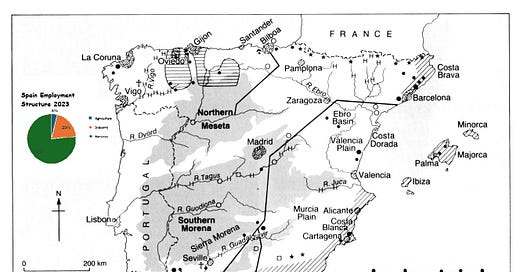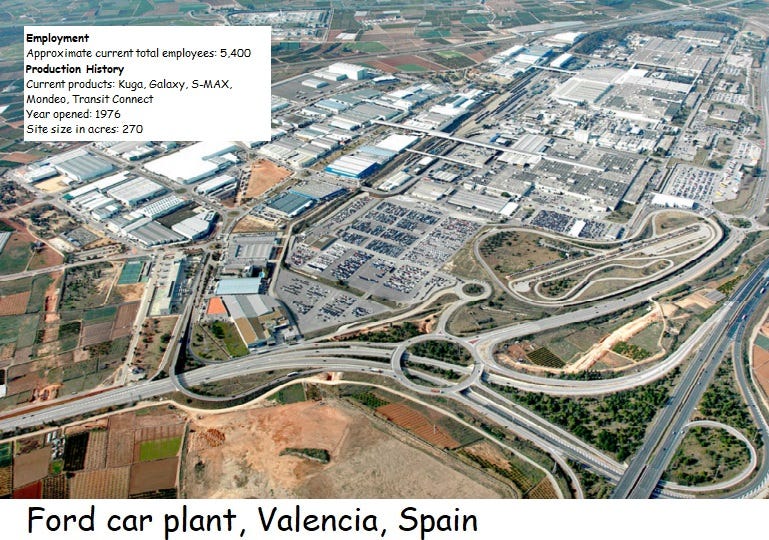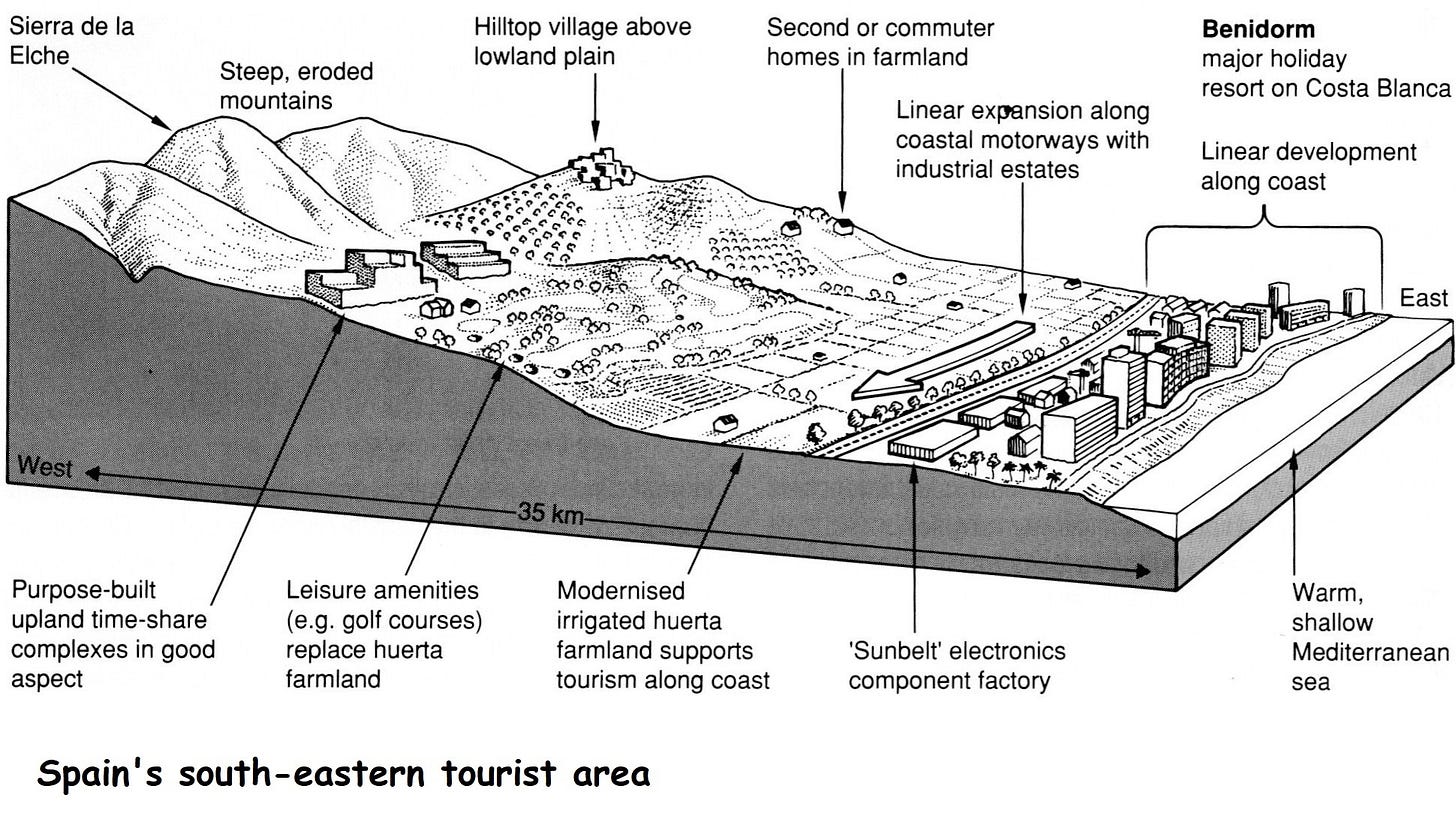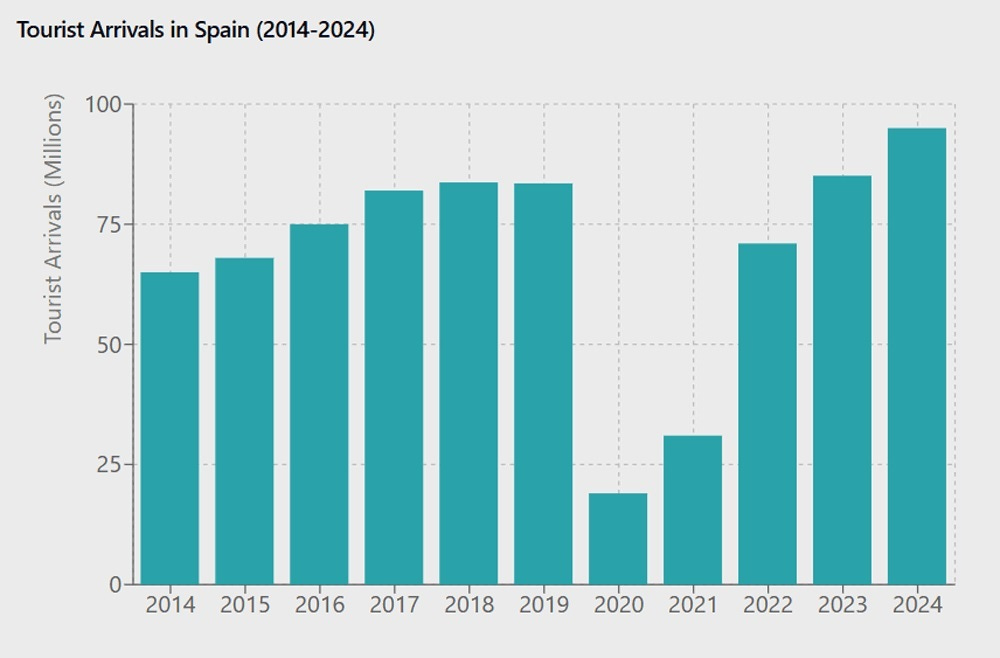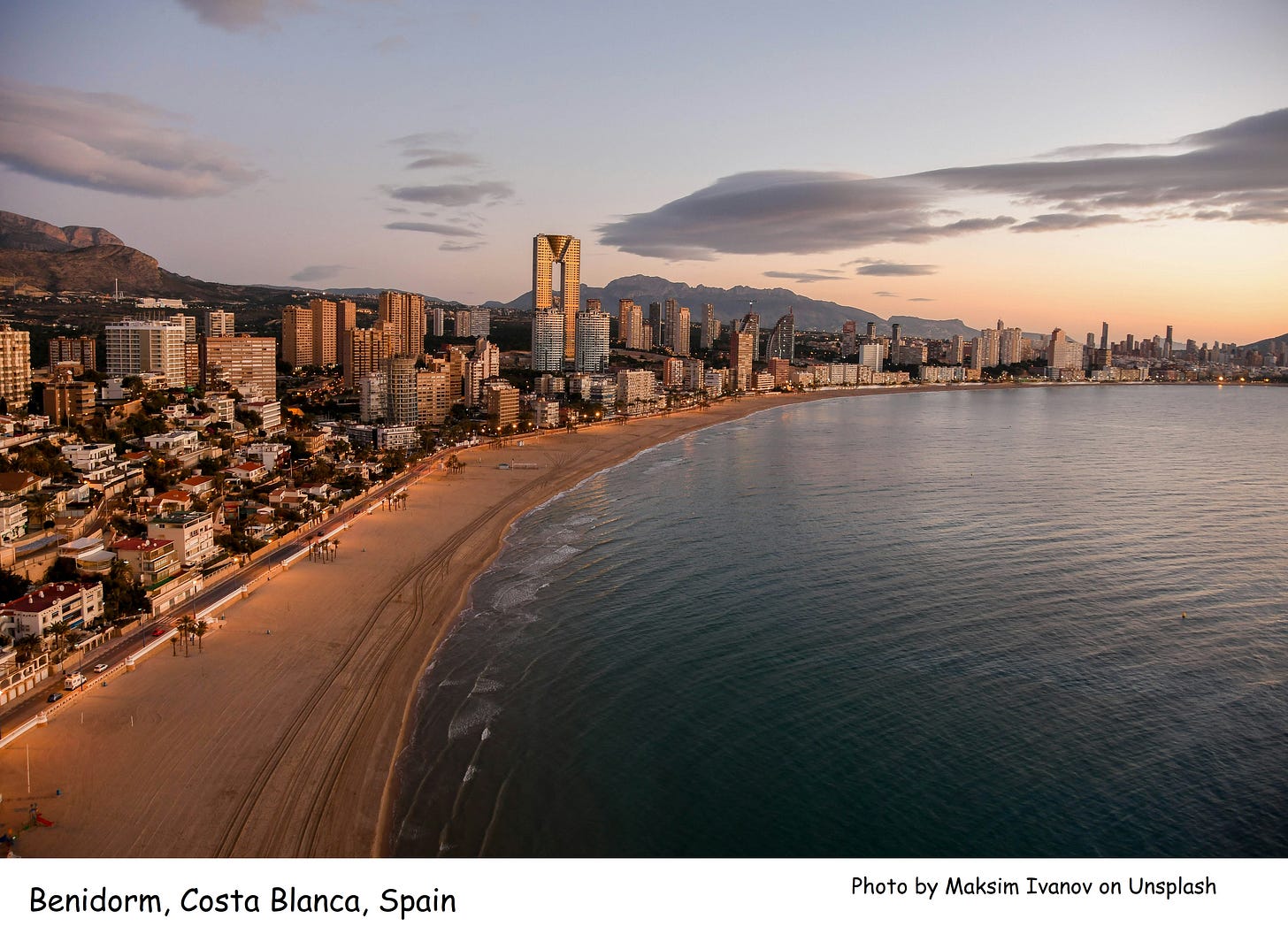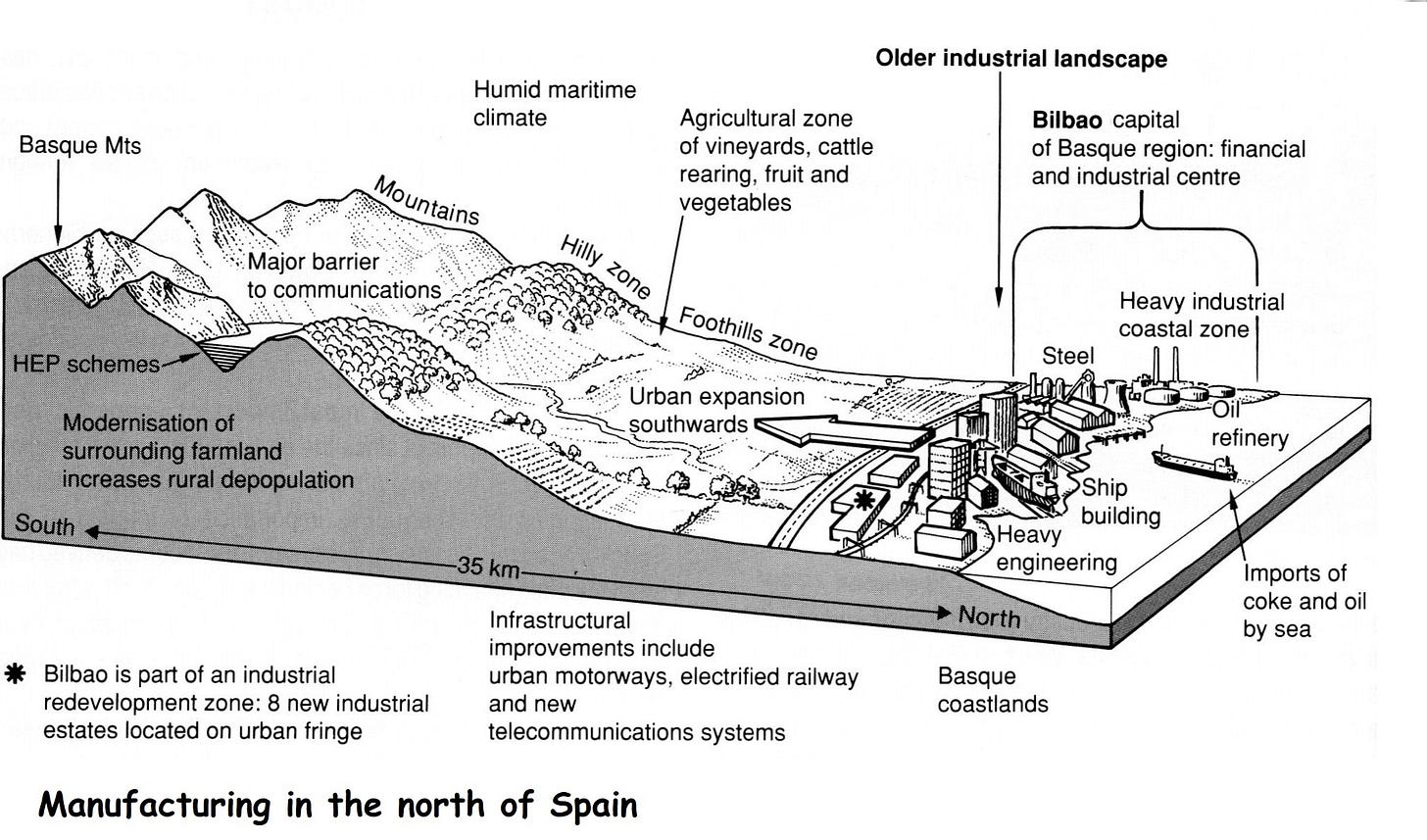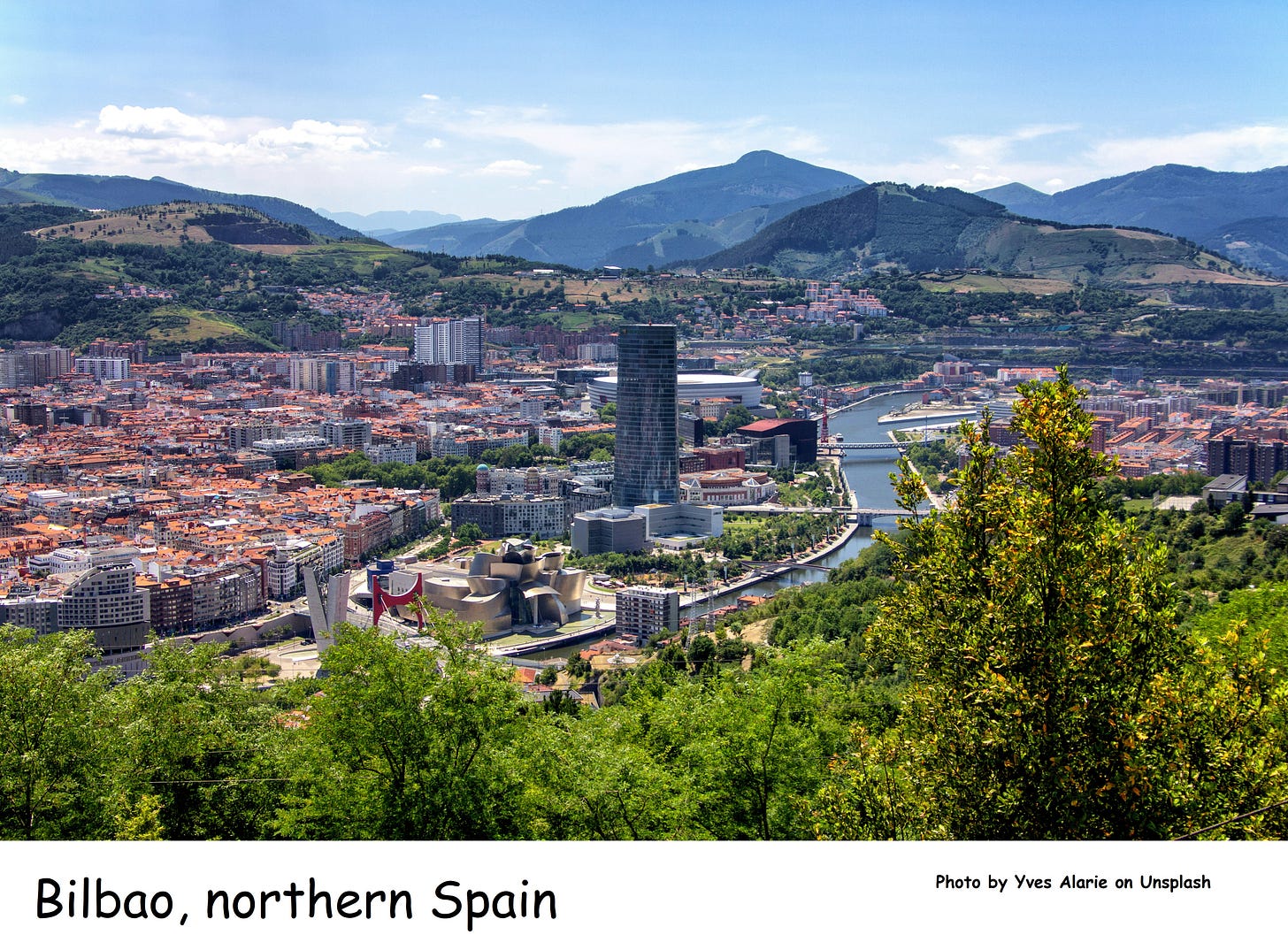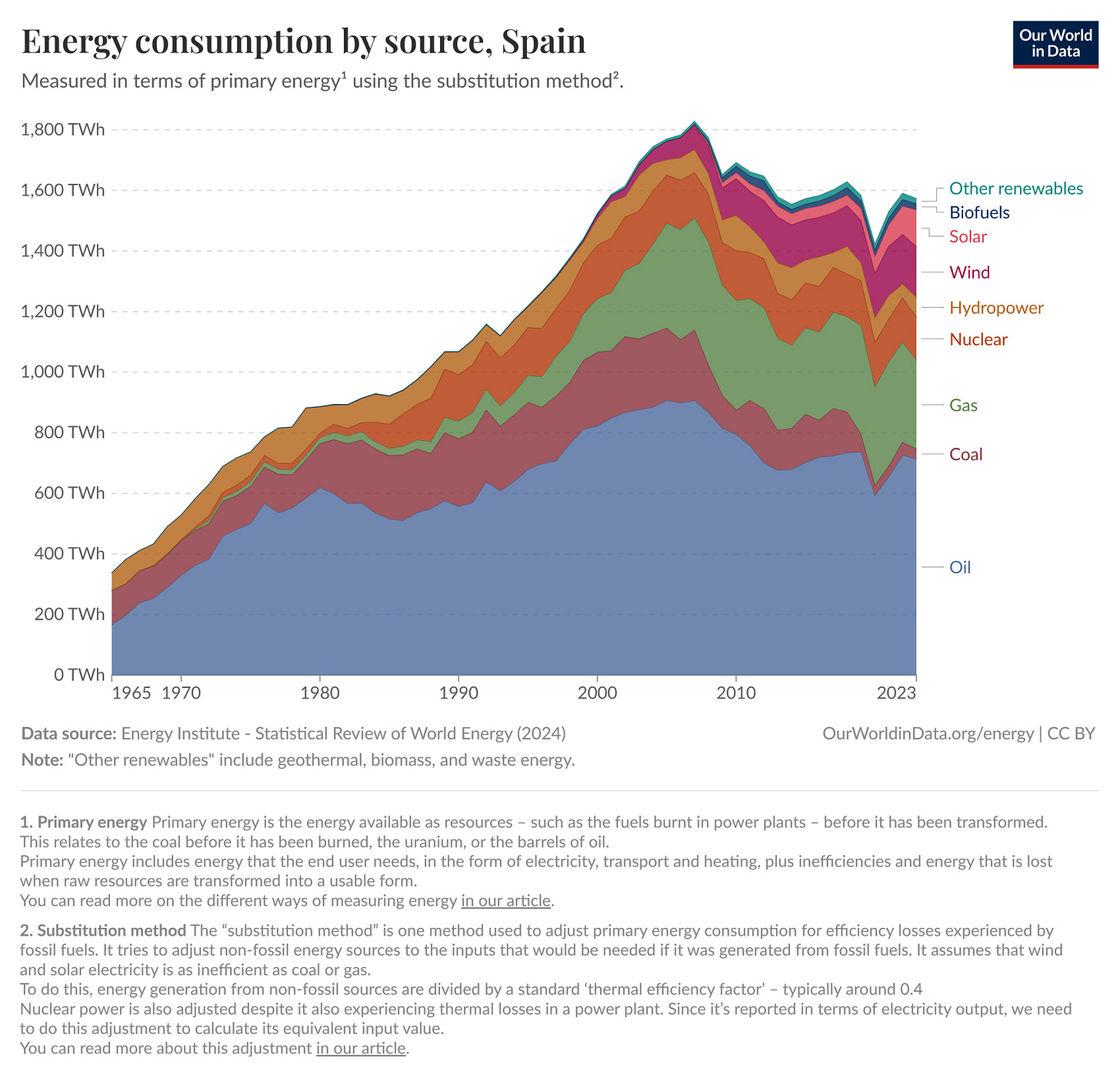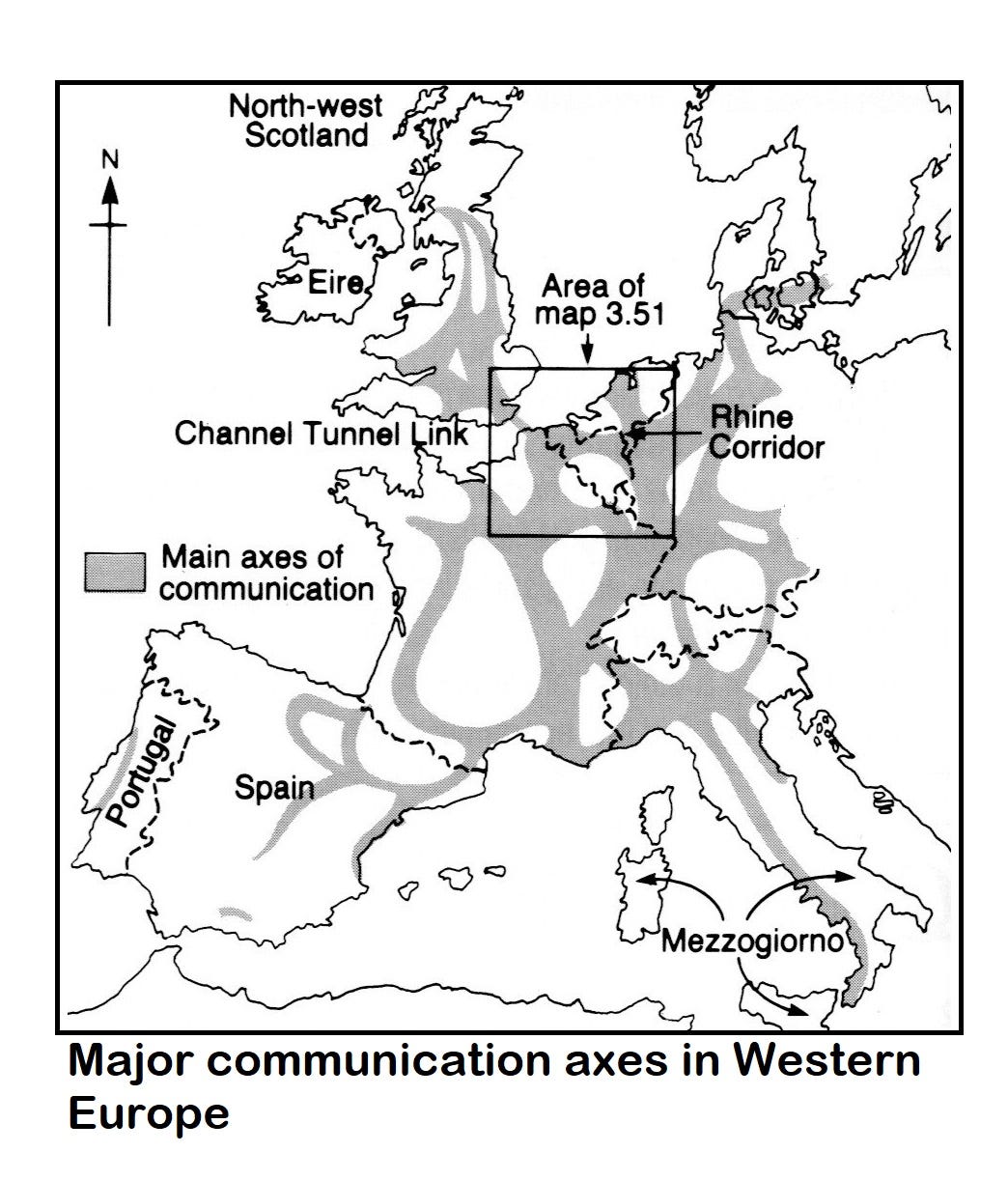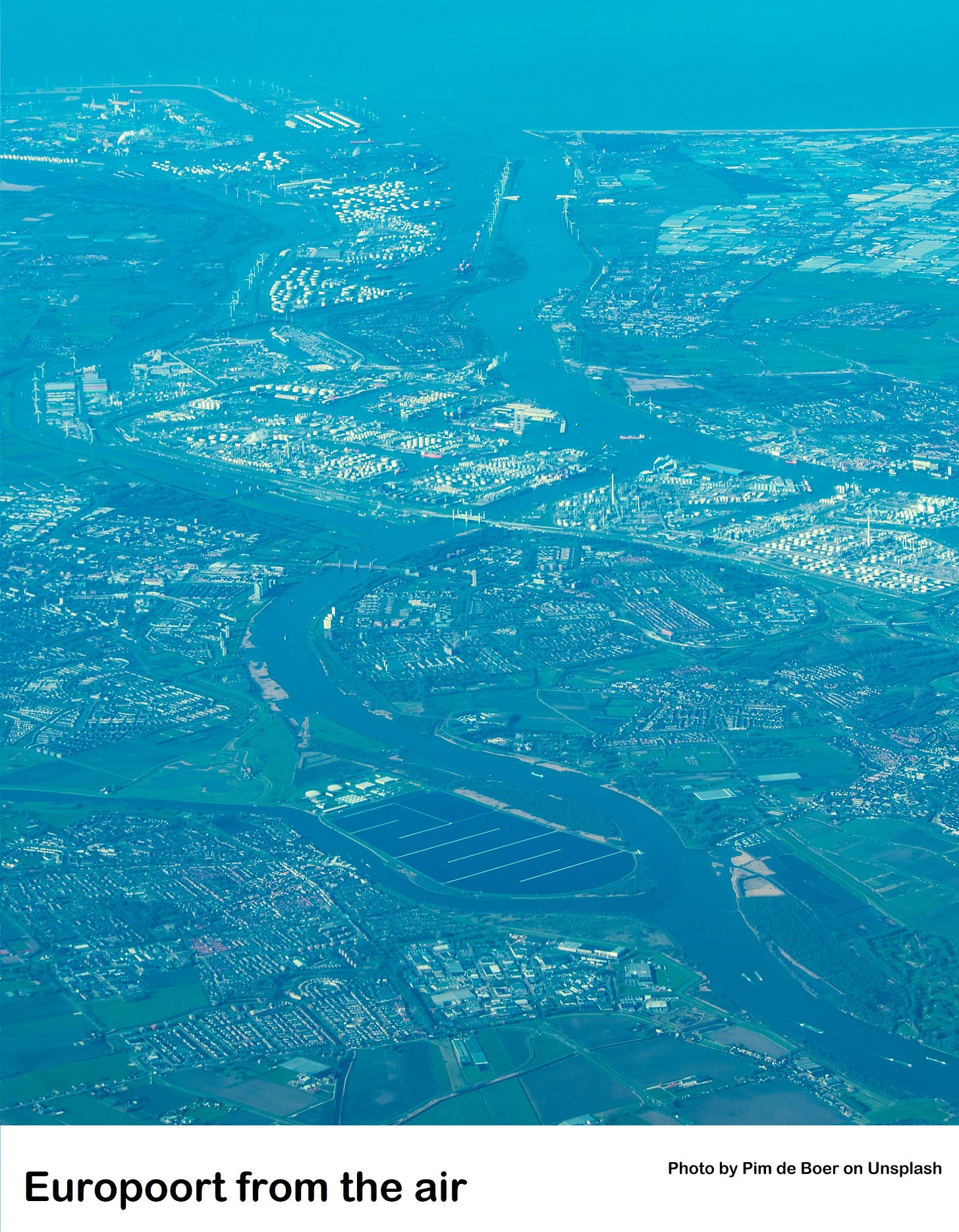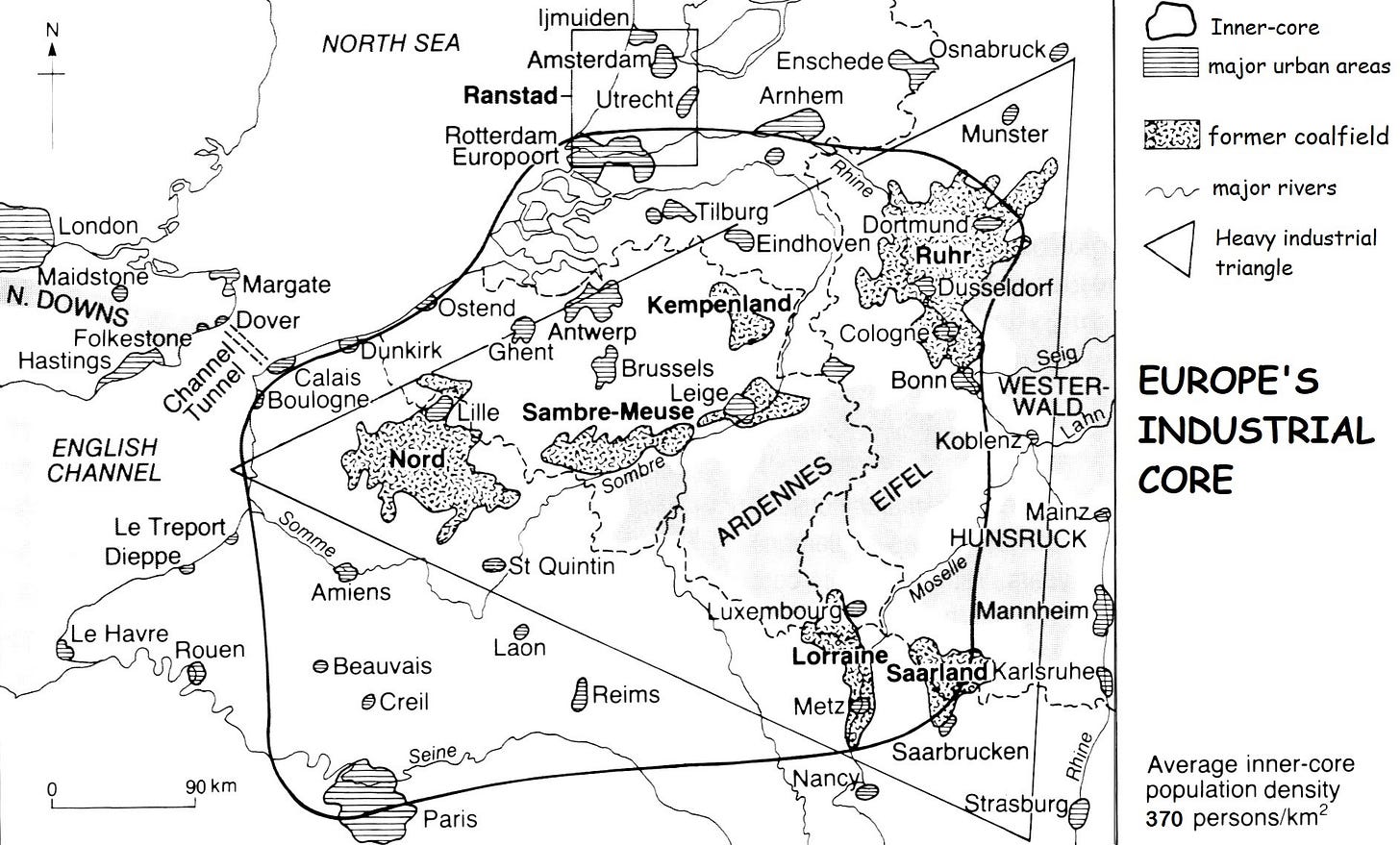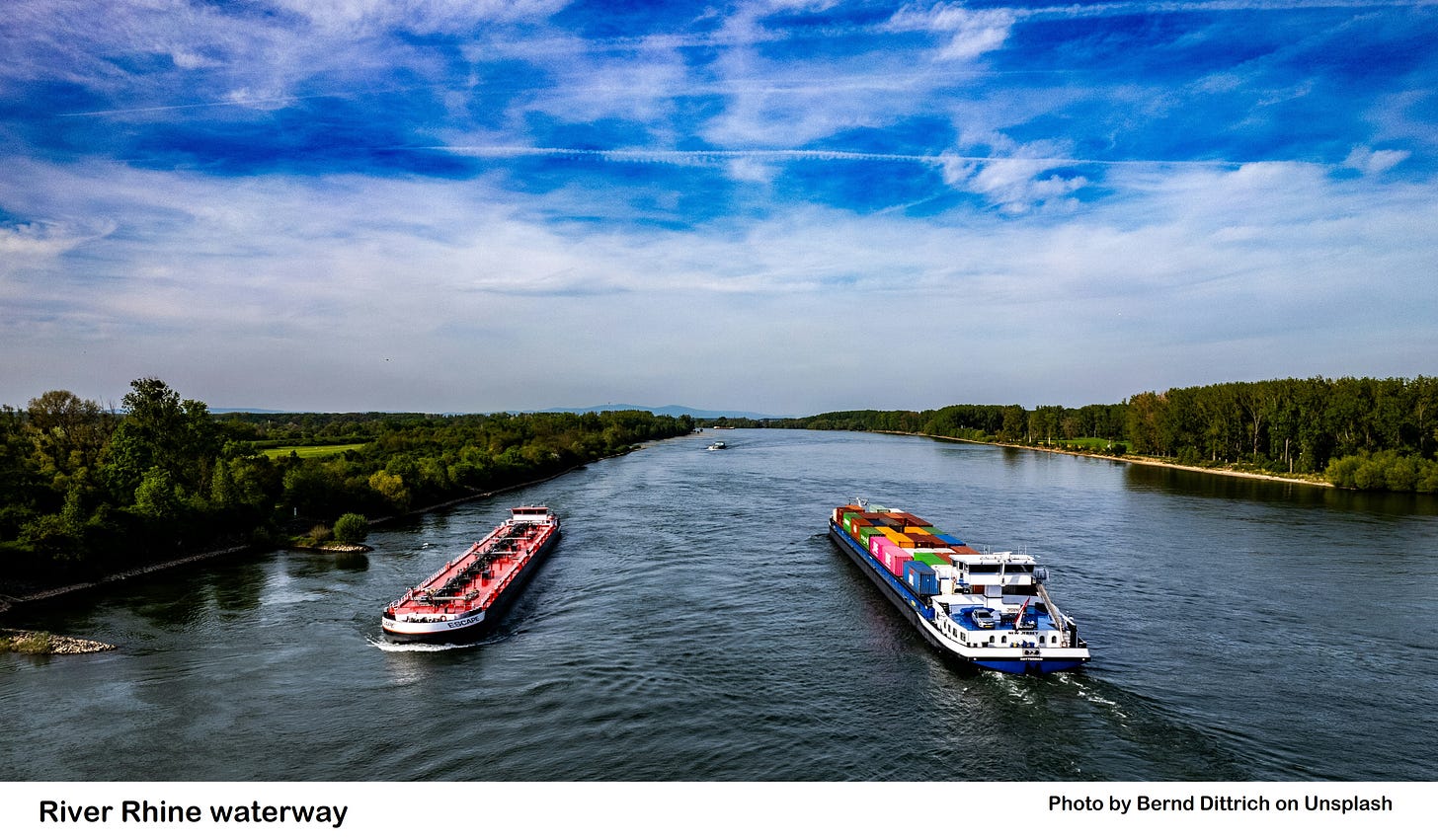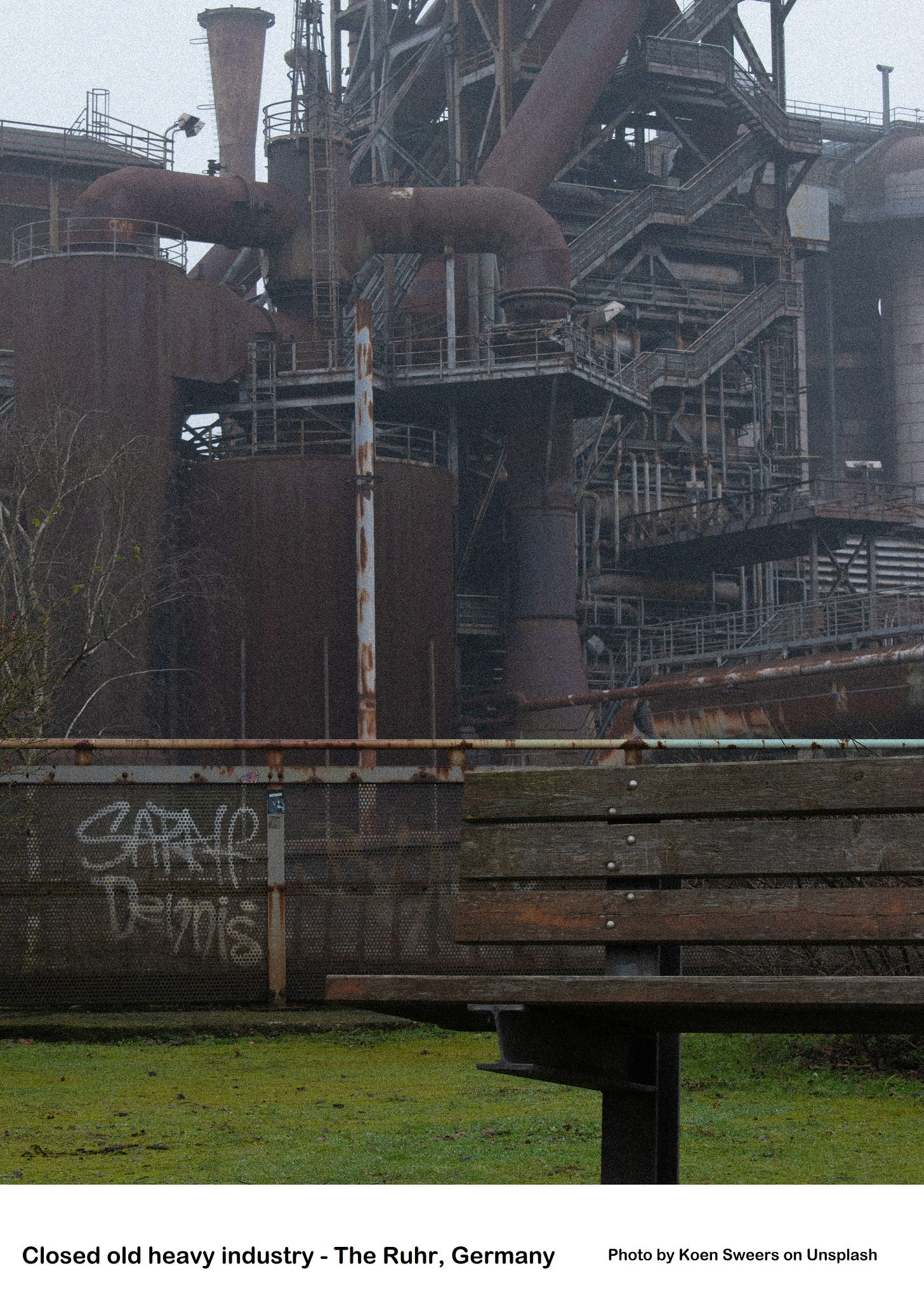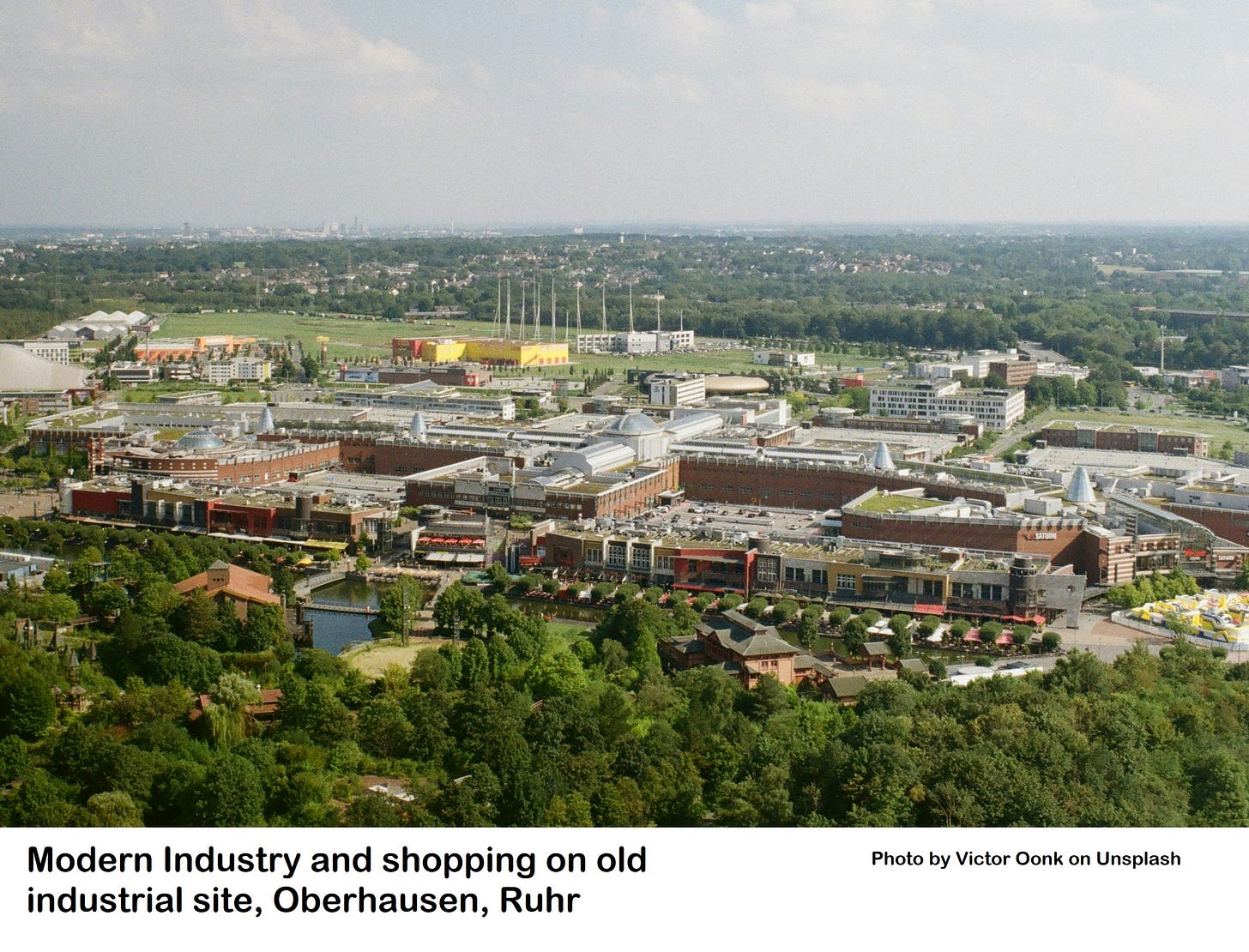The diverse industrial landscape of Spain
Spain has a diverse industrial landscape, with various sectors contributing to its economy. Spain with a population of around 48 million people has witnessed a rapid industrialisation since the 1960’s. The Stabilisation Plan of 1959 represented the first attempt to liberalise and internationalise the Spanish economy, and its success brought in billions of dollars in international investment. In 1950, 49% of the Spanish workforce were working in Agriculture in 2023 only 4% work in Agriculture. The numbers working in manufacturing in 1950 was around 25% of the labour force - this rose steeply to 37% of the labour force in 1973 and 50 years later in 2023 it reduced to 20% but the growth in Service industries has risen from 52% in 1990 to 76% in 2023.
Food and Beverage Industry:
Spain is renowned for its gastronomy and produces a wide range of food and beverage products. The country is a major exporter of agricultural products such as fruits, vegetables, olive oil, wine, and cured meats. The food and beverage industry encompasses both traditional and modern sectors, with regions like Andalusia, Catalonia, and Valencia being significant agricultural and food processing hubs. Spain is the world's largest producer of olive oil and the world's third-largest producer of wine. The country is also one of the largest producers of oranges and strawberries in the world. The main crops are wheat, sugar beet, barley, tomatoes, olives, citrus fruits, grapes and cork. Livestock is also important, especially for pigs and cattle: Spain accounted for about one-quarter of the EU's pig (25.4%) and sheep (23.6%) populations in 2023.
Large Hydroelectric schemes such as those on the Tagus, not only provide irrigation for farms but have also generated large-scale industrial activity. Agriculture contributes around 2.5% of the Spanish GDP and employs 4% of the workforce (World Bank, latest data available). The country is home to almost one million agricultural and livestock businesses, covering 30 million hectares of land. Despite Spain being a very important agricultural producer the share of GDP from farming has fallen substantially as Spain earns more from manufacturing and services such as banking. (in 1990 Agriculture contributed around 20% of GDP)
The industrial sector accounts for one-fifth of GDP and employment. Manufacturing as a whole is the most important sector as it accounts for around 11% of GDP (World Bank). The industrial sector is dominated by automotive, textiles, industrial food processing, iron and steel, naval machines, and engineering. New sectors such as outsourcing of electronic components production, information technology, and telecommunications provide high growth potential.
Automotive Industry:
Spain is the second-largest automotive manufacturer in Europe, with exports accounting for over 60% of industrial production. The automotive industry is concentrated in regions such as Catalonia, Valencia, and Madrid. Major Spanish automakers like SEAT (part of the Volkswagen Group), Renault and Ford have production plants in the country. The automotive sector supports a significant number of jobs and generates substantial export revenue.
Tourism and Hospitality:
The physical advantages of the Mediterranean coastline: the hot sunny summers, with up to 10 hours of sunshine daily, attractive coastline and scenery, warm sea, sheltered beaches, very mild winters and affordable holidays were major considerations in the development of Spain’s very important tourism industry.
The construction of coastal airports and improved road and rail connections, together with the advent of packaged holidays and low-cost airlines has contributed to the ribbon developments along larges sections of the Mediterranean coastline. Turning small fishing villages into skyscraper tourist resorts.
Tourism plays a vital role in the Spanish economy, contributing significantly to GDP and employment. Spain is a popular tourist destination known for its beaches, historical sites, vibrant cities, and cultural attractions. The tourism and hospitality industry encompasses hotels, resorts, restaurants, travel agencies, and related services, and it is particularly prominent in coastal regions, the Balearic and Canary Islands, and major cities like Barcelona and Madrid.
The tertiary sector as a whole contributes 68.7% of the GDP and employs 76% of the active population. The tourism sector is pivotal for the country’s economy, being Spain’s main source of income, as the country is the second-most popular tourist destination in the world. According to the latest official figures, tourism contributed 12.3% of GDP and employed 11.6% of the total number of national insurance contributors in 2023, generating a turnover of EUR 184 billion.
Visitor numbers have climbed from the tourist boom of the 1960’s when around 42 million visitors chose Spain for their holiday. In 2023 closer to 100 million people visit Spain annually. In some tourist areas, there have been protests against over-tourism as young people in particular have been priced out of the housing market.
The Spanish tourist industry since the 1960s
The tourist industry in Spain has experienced significant development and growth since the 1960s, transforming the country into one of the world’s leading tourist destinations
Early Tourism Development (1960s-1970s): The development of mass tourism in Spain can be traced back to the 1960s. The country’s favourable climate, beautiful beaches, and affordable prices attracted tourists, primarily from neighbouring European countries like the United Kingdom, Germany, and France. During this period, Spain focused on attracting sun and beach tourists, with regions like Costa del Sol, Costa Brava, and Costa Blanca becoming popular destinations.
Government Support and Infrastructure Development: The Spanish government recognised the potential of tourism as a key driver of economic growth. They implemented policies to support the industry, including investing in infrastructure development and promoting Spain as a tourist destination. Airports, roads, and hotels were built to accommodate the increasing number of visitors. Government initiatives and favourable regulations encouraged the construction of resorts, hotels, and tourist facilities along the coastlines.
Diversification of Tourism Offerings (1980s-1990s): In the 1980s and 1990s, Spain focused on diversifying its tourism offerings beyond sun and beach tourism. Efforts were made to promote cultural tourism, historical sites, and city destinations. Popular cities like Barcelona, Madrid, and Seville became tourist magnets due to their architectural wonders, cultural heritage, and vibrant nightlife. The country’s rich history, including UNESCO World Heritage Sites like Alhambra, Sagrada Familia, and Toledo, attracted a new segment of tourists interested in cultural experiences.
International Promotion and Marketing: Spain launched extensive international marketing campaigns to attract tourists from around the world. The “Spain is Different” campaign in the 1960s and subsequent campaigns highlighted Spain’s unique cultural, natural, and historical attractions. Tourism fairs, trade shows, and collaborations with travel agencies helped promote Spain as a desirable destination. The country’s participation in international events like the 1992 Barcelona Olympics and the 1992 Seville Expo further enhanced its global image.
Collaboration with Tour Operators and Airlines: Collaboration with tour operators and airlines played a crucial role in the development of Spain’s tourist industry. Partnerships were established with travel agencies, tour operators, and airlines to create package holiday deals and promote Spain as an accessible destination. Charter flights and discounted holiday packages made Spain an affordable and convenient choice for tourists.
Hotel and Resort Development: The growth of tourism led to the construction of hotels and resorts across the country. The Spanish coastline saw the development of numerous hotel complexes and resorts, catering to the demand for beach holidays. Luxury resorts, all-inclusive hotels, and boutique accommodations emerged to cater to diverse traveller preferences and budgets.
Sustainable Tourism and Quality Improvement: In recent years, Spain has focused on sustainable tourism practices and quality improvement. Efforts have been made to preserve natural areas, promote responsible tourism, and reduce the environmental impact of the industry. Quality certifications and standards have been introduced to enhance the visitor experience and maintain Spain’s reputation as a top tourist destination.
Increasing International Visitors and Tourism Revenue: The development of Spain’s tourist industry has led to a significant increase in international visitors and tourism revenue. In recent years, Spain consistently ranks among the top tourist destinations globally. The country attracts visitors from all over the world, including Europe, the Americas, Asia, and the Middle East. Tourism revenue has become a significant contributor to Spain’s economy, supporting jobs, businesses, and regional development.
Spain’s tourist industry has evolved from its early focus on sun and beach tourism to a more diversified offering.
The manufacturing heartland of Spain on the north coast
The manufacturing heartland of Spain on the north coast is primarily concentrated in the Basque Country and Catalonia regions.
Basque Country: The Basque Country, located in the northern part of Spain, has a strong industrial tradition and is known for its advanced manufacturing sector. Key cities like Bilbao, San Sebastian, and Vitoria-Gasteiz are centres of industrial activity.
Bilbao’s industrial sector includes steel manufacturing, shipbuilding, and logistics. Some of the most recognisable industrial companies in Bilbao include ArcelorMittal, a multinational steel manufacturing company, and Astilleros del Nervión, a shipbuilding company that has been operating in the city for over a century. Other notable companies in the region include the logistics firm Bergé y Cía, which provides transportation and storage services, and Iberdrola, a leading energy company. Despite the challenges faced by the global industrial sector in recent years, Bilbao's industrial companies continue to play a vital role in the city's economy, providing jobs and driving growth.
a) Automotive Manufacturing: The Basque Country is a major hub for automotive manufacturing. Renowned companies like Mercedes-Benz, Volkswagen, and Michelin have production facilities in the region. The automotive sector in the Basque Country specialises in the production of components, such as engines, transmissions, and chassis.
b) Machine Tools and Capital Goods: The region is also recognised for its expertise in machinetools and capital goods manufacturing. Companies like Danobat, Fagor Automation, and Ona Electroerosión are leading providers of machine tools and equipment, catering to various industries worldwide.
c) Energy and Renewables: The Basque Country has also made significant strides in the energy sector, including renewable energy. Companies like Gamesa (now Siemens Gamesa) and Ingeteam are involved in the production of wind turbines and renewable energy technologies.
d) Advanced Materials and Aerospace: Spain has a thriving aerospace and defence industry. Companies like Airbus and Indra have a strong presence in the country. Spain manufactures aircraft components, assembles helicopters, and develops defence systems. The aerospace industry is concentrated in regions like Andalusia, Madrid, and Catalonia, with specialised aerospace technology parks and research centres. The Basque Country is home to advanced materials research and development centres, focusing on areas such as composite materials and nanotechnology. Aerospace companies like Aernnova and Sener Aeroespacial have a presence in the region.
Catalonia: Catalonia, in north-eastern Spain, is another significant manufacturing region with a diverse industrial landscape. Barcelona, the capital city, is a major industrial hub.
a) Textiles and Fashion: Spain has a rich tradition in textiles and fashion. Regions like Catalonia and Valencia are known for their textile production and fashion design. Barcelona hosts major fashion events, and Spanish brands like Zara, Mango, and Desigual have gained global recognition. The textile and fashion industry encompasses clothing manufacturing, textile mills, and fashion retail. Catalonia has a long history of textile production, and the region remains a centre for the textile and fashion industry. Barcelona hosts renowned fashion events like Barcelona Fashion Week, and the city is home to major textile manufacturers and fashion designers
b) Chemicals and Pharmaceuticals: Spain has a significant presence in the chemical and pharmaceutical sectors. The country produces a wide range of chemical products, including plastics, fertilisers, and pharmaceuticals. Regions like Catalonia, Basque Country, and Valencia are home to major chemical and pharmaceutical companies. Barcelona, in particular, has become a hub for pharmaceutical research and development. Catalonia has a strong presence in the chemicals and pharmaceuticals sectors. The region hosts chemical companies like BASF, Dow Chemical, and IQOXE, and pharmaceutical companies like Almirall and Grifols.
c) Food and Beverage: Catalonia is known for its gastronomy and is a hub for food and beverage production. The region produces renowned wines, cava (sparkling wine), and traditional Catalan cuisine. Barcelona’s famous Boqueria Market is a major food destination.
d) Electronics and Information Technology: Spain has a growing IT and telecommunications sector. Companies in this industry offer software development, IT services, telecommunications infrastructure, and digital solutions. Technological hubs like Barcelona, Madrid, and Valencia attract startups, tech companies, and research institutions. Catalonia has a thriving electronics and IT industry. The region is home to companies like SEAT (part of the Volkswagen Group), Telefonica, and Tech Data. Barcelona hosts the Mobile World Congress, a leading event in the telecommunications industry.
e) Machinery and Equipment: Catalonia also excels in machinery and equipment manufacturing. Companies like Ficosa International, Fluidra, and Roca produce machinery, equipment, and components for various sectors.
These regions, the Basque Country and Catalonia, are key drivers of Spain’s manufacturing sector, contributing significantly to the country’s industrial output, employment, and export earnings. The manufacturing heartland on the north coast demonstrates Spain’s capabilities in diverse industries, innovation, and technological advancements.
ENERGY CONSUPTION IN SPAIN
Spain has made significant strides in renewable energy development, particularly in the wind and solar sectors. The percentage of energy production from renewables has risen to 25% of the total energy production. The country is among the top renewable energy producers in Europe. Regions like Castilla-La Mancha, Andalusia, and Catalonia have seen substantial investment in wind farms and solar power plants. The renewable energy sector has created jobs and contributed to Spain’s efforts to reduce carbon emissions. However, 66% of Spain’s energy production and consumption comes from fossil fuels.
The European industrial inner core is centred on Brussels
The most densely populated regions of the Euro-core, with their high accessibility to labour force, markets, finance, etc., have the major advantage of a communications network which efficiently interlinks the main industrial and urban centres.
The integration of transport systems reinforces access to the core regions usually at the expense of the peripheral areas. Along the main corridors of communication, for example the Rhine corridor from Europoort to Basle, economic activity is stimulated.
The European industrial inner core, centred on Brussels, encompasses a region that is often referred to as the Brussels-Capital Region. This region serves as the administrative and political centre of the European Union (EU) and is characterised by a diverse and dynamic industrial landscape.
1. Services and Knowledge Economy: The Brussels-Capital Region is primarily known for its services and knowledge-based economy. It is home to numerous EU institutions, international organisations, and diplomatic missions, which drive the service sector and contribute to the region’s economic activity. The presence of these institutions also fosters a knowledge economy, attracting professionals in fields such as law, economics, politics, and international relations.
2. Finance and Banking: Brussels serves as a financial hub within Europe. The region is home to several national and international banks, insurance companies, and financial institutions. The presence of the EU institutions and headquarters of major multinational corporations further supports the finance and banking sector in the Brussels-Capital Region.
3. Administrative and Government Services: As the political capital of the EU, the Brussels- Capital Region hosts a significant number of administrative and government services. This includes EU institutions, such as the European Commission as well as various governmental offices and agencies. These institutions and services create a demand for administrative support, legal services, and consulting.
4. Research and Development: The Brussels-Capital Region also fosters research and development activities. It houses numerous research centres, universities, and academic institutions that focus on various disciplines, including science, technology, and innovation. The region actively promotes collaboration between academia and industry, fostering innovation and technological advancements.
5. Creative Industries: Brussels has a vibrant creative industry sector, encompassing areas such as design, architecture, advertising, and media. The region supports creative professionals and businesses, providing an environment conducive to artistic and cultural expression. The presence of galleries, museums, theatres, and cultural festivals further contributes to the creative industries in the Brussels-Capital Region.
6. Logistics and Transportation: The Brussels-Capital Region serves as a major transportation and logistics hub within Europe. Its central location makes it an ideal hub for national and international distribution networks. The region has efficient transportation infrastructure, including road networks, airports, and rail connections, facilitating the movement of goods and people.
7. Technology and Innovation: The Brussels-Capital Region promotes technological innovation and entrepreneurship. It supports startups, incubators, and accelerators, fostering a culture of innovation and creativity. The region hosts technology parks and clusters, bringing together businesses and research institutions to promote collaboration and knowledge exchange.
8. Hospitality and Tourism: Brussels attracts a significant number of tourists and business travellers due to its status as the capital of the EU. The region offers a range of hospitality services, including hotels, restaurants, and conference facilities. The tourism sector contributes to the region’s economy and provides employment opportunities.
9. Environmental and Sustainable Development: The Brussels-Capital Region places a strong emphasis on environmental sustainability and sustainable development. It actively promotes green initiatives, including renewable energy, waste management, and urban sustainability. The region serves as a platform for discussions and actions related to environmental and climate issues.
The Brussels-Capital Region serves as the industrial inner core of Europe, centred on administrative, political, and economic activities. It is characterised by a diverse range of industries, including services, finance, research and development, creative industries, logistics, technology, and hospitality. The region’s strategic location and its role as the heart of the EU contribute to its economic significance and influence in Europe.
The importance of the River Rhine for industry, communication and cohesion
The River Rhine holds great importance for industry, communication, and cohesion in Europe. It is one of the longest and busiest rivers in the continent, stretching over 1,230 kilometres and flowing through multiple countries.
1. Industrial Hub: The Rhine River serves as a vital transportation artery for industrial activities in Europe. It connects major industrial regions, such as the Ruhr Valley in Germany, which is known for its coal, steel, and chemical industries. The river provides a cost-effective and efficient mode of transportation for the movement of raw materials, goods, and resources, supporting the industrial supply chain.
2. Inland Waterway Transport: The Rhine River forms a crucial part of Europe’s inland waterway transport system. It is navigable throughout a large portion of its length, allowing for the transportation of goods by barges and ships. Inland waterway transport is cost-effective, energy-efficient, and environmentally friendly, reducing congestion on roads and railways. The Rhine connects industrial centres with key ports, such as Rotterdam in the Netherlands, facilitating international trade and commerce.
3. Trade and Economic Integration: The Rhine River plays a significant role in facilitating trade and economic integration in Europe. It provides a direct link between the industrial regions of Switzerland, Germany, France, and the Netherlands, allowing for the seamless movement of goods and fostering economic cooperation. The river serves as a key trade route for exporting and importing goods, strengthening the economic ties between countries along its course.
4. Energy Generation: The Rhine River serves as an important source of hydroelectric power generation. Numerous hydroelectric power plants are located along the river, harnessing its water flow to produce renewable energy. This contributes to the region’s energy mix, supporting sustainable development and reducing reliance on fossil fuels.
5. Tourism and Recreation: The picturesque landscapes, historical sites, and cultural attractions along the Rhine River make it a popular tourist destination. River cruises, cycling routes, and walking trails attract visitors who seek to explore the scenic beauty and rich heritage of the regions traversed by the river. Tourism along the Rhine supports local economies and promotes cultural exchange.
6. Environmental Importance: The Rhine River has witnessed significant efforts to improve its water quality and protect the surrounding ecosystems. Various initiatives and international agreements have been implemented to reduce pollution, restore habitats, and preserve biodiversity along the river. These environmental efforts contribute to the overall environmental well-being of the region and promote sustainable development.
7. Cultural and Historical Significance: The Rhine River holds cultural and historical significance in Europe. It has been a border and a corridor of trade, commerce, and migration for centuries. The river has witnessed the rise and fall of civilisations, witnessed battles, and influenced the development of local cultures and traditions. Its rich history and cultural heritage contribute to the sense of cohesion and shared identity among the countries and regions connected by the river.
In summary, the Rhine River plays a crucial role in supporting industrial activities, facilitating transportation and trade, promoting economic integration, generating renewable energy, fostering tourism, and preserving the environment in Europe. It serves as a symbol of cohesion and interconnectedness, connecting diverse regions and countries along its course.
Industrial transition of the Ruhr since the Second World War
The Ruhr region, located in western Germany, has undergone a significant industrial transition since the Second World War. Historically known for its heavy industry, particularly coal and steel production, the region has experienced a shift in its industrial landscape.
1. Post-War Reconstruction: After the Second World War, the Ruhr region faced extensive damage to its infrastructure and industries. The reconstruction efforts focused on reviving the coal and steel sectors, which were crucial for the region’s economy. The coal mines and steel mills were rebuilt and modernised, laying the foundation for the region’s industrial revival.
2. Economic Diversification: In the 1960s and 1970s, the Ruhr region began to diversify its industrial base to reduce its dependence on coal and steel. This diversification was driven by the declining demand for coal and increased competition from other countries. The region started to attract new industries, including chemical production, automotive manufacturing, machinery, electronics, and services.
3. Decline of Coal Mining: The decline of coal mining played a significant role in the industrial transition of the Ruhr region. As coal reserves depleted and global energy markets shifted towards alternative sources, the coal mining industry faced numerous challenges. The closure of many coal mines resulted in significant job losses and required efforts to transition to other industries.
4. Restructuring and Modernisation: To adapt to changing economic realities, the Ruhrregion underwent a process of restructuring and modernization. Older industrial facilities were closed or transformed, and new technologies and production methods were introduced to improve efficiency and competitiveness. The region embraced automation, digitalisation, and innovation to enhance productivity and meet the demands of the global market.
5. Shift towards Services and Knowledge Economy: As heavy industry declined, the Ruhr region increasingly shifted towards the service sector and the knowledge economy. The region capitalised on its strong educational institutions, research centres, and skilled workforce to attract high-tech industries, research and development activities, and knowledge-intensive services. This transition led to the emergence of technology parks, innovation clusters, and start-up incubators.
6. Environmental and Sustainable Focus: The industrial transition of the Ruhr region also involved a growing emphasis on environmental sustainability. Efforts were made to address the environmental impact of heavy industry, improve air and water quality, and promote sustainable practices. The region invested in renewable energy, energy-efficient technologies, and eco-friendly infrastructure, positioning itself as a leader in sustainable development.
7. Urban Renewal and Cultural Transformation: The industrial transition of the Ruhr region had a profound impact on its urban landscape and cultural identity. Former industrial sites were transformed into cultural and recreational spaces, such as museums, art galleries, parks, and concert venues. The region embraced its industrial heritage and leveraged it as a unique selling point for tourism and cultural experiences.
8. Regional Collaboration and Cohesion: Throughout the industrial transition, the Ruhr region prioritised regional collaboration and cohesion. Cooperation between municipalities, businesses, educational institutions, and government entities played a crucial role in supporting the transformation efforts. Regional development programs, funding initiatives, and partnerships were established to drive innovation, job creation, and economic growth.
The industrial transition of the Ruhr region since the Second World War has involved diversification, modernisation, and a shift towards services, knowledge-intensive industries, and sustainability. The region has successfully adapted to changing economic dynamics, leveraging its strengths to emerge as a vibrant and innovative industrial hub in Germany and Europe. Its key locational advantage in the Euro Core, with good communications, market accessibility and skilled labour force have enabled it to transition from heavy industry to a region with diverse modern industries and a vibrant service sector.
Examination Questions
SPAIN
Short Answer Questions
Describe how the structure of Spain’s workforce has changed from 1950 to 2023, focusing on the primary, secondary, and tertiary sectors.
Identify three major agricultural products for which Spain is a leading global producer or exporter.
Name two regions in Spain that are significant hubs for the food and beverage industry and explain why.
Briefly explain why the tourism sector is so important to Spain’s economy.
Data Response Questions
Using the data provided, calculate the percentage point change in the proportion of the Spanish workforce employed in agriculture between 1950 and 2023.
Examine the trend in the contribution of agriculture to Spain’s GDP from 1990 to 2023.
Discuss the impact of tourism on housing markets in some Spanish tourism regions.
Structured/Essay Questions
Assess the reasons for the growth and diversification of Spain’s tourism industry since the 1960s.
Discuss the main factors that contributed to the rapid industrialisation of Spain after the 1960s.
Explain how Spain’s manufacturing sector has changed in terms of employment and output from 1950 to 2023.
Compare and contrast the industrial specialisations of the Basque Country and Catalonia, giving examples of key industries in each region.
Case Study/Application Questions
The Basque Country and Catalonia are described as Spain’s manufacturing heartland. Explain the importance of these regions to Spain’s overall industrial output and export earnings.
Evaluate the impact of renewable energy development on Spain’s economy and environment, referencing specific regions where appropriate.
Map/Location Questions
On a blank map of Spain, mark and label the following regions: Basque Country, Catalonia, Andalusia, Valencia, and Castilla-La Mancha. For each, state one key industrial or economic activity.
Identify two coastal regions that became popular tourist destinations during Spain’s tourism boom in the 1960s and explain why they attracted visitors.
Multiple Choice Questions
Which of the following industries is NOT a major part of Spain’s industrial sector?
A) Automotive manufacturing
B) Textile and fashion
C) Oil refining
D) Food and beverage processing
In 2023, what percentage of Spain’s workforce was employed in the service sector?
A) 20%
B) 52%
C) 76%
D) 68.7%
Spain is the world’s largest producer of which product?
A) Wine
B) Olive oil
C) Oranges
D) Wheat
EURO CORE
Short Answer Questions
Define the term "European industrial inner core" and identify its central city.
List three key sectors that contribute to the economy of the Brussels-Capital Region.
Explain two advantages that the Euro-core’s communications network provides for industry and urban centers.
Describe the significance of the River Rhine for industrial activities in Europe.
Name two ways in which the Ruhr region has diversified its economy since the Second World War.
Data Response/Structured Questions
Discuss how the integration of transport systems in the Euro-core affects peripheral regions.
Outline the main functions of the Brussels-Capital Region as the administrative and political center of the EU.
Explain how the Rhine River facilitates economic integration and trade between European countries.
Describe the process of industrial transition in the Ruhr region from the 1960s to the present, highlighting the shift from heavy industry to a service and knowledge-based economy.
Essay/Extended Response Questions
Assess the role of research and development in the economic transformation of the Brussels-Capital Region1.
To what extent has the Ruhr region’s industrial transition been successful in promoting sustainable development and urban renewal?
Evaluate the importance of logistics and transportation infrastructure in maintaining the economic significance of the Euro-core.
Discuss the cultural and historical significance of the Rhine River and how it contributes to cohesion among European countries.
Compare and contrast the industrial changes experienced by the Ruhr region with those of another major European industrial area (using your own knowledge for comparison).
Map/Location Questions
On a blank map of Europe, mark and label the Brussels-Capital Region, the Ruhr region, and the Rhine River. For each, briefly state their economic importance1.
Identify the main industrial corridor mentioned in the text and explain its significance for economic activity in the Euro-core.
Multiple Choice Questions
Which of the following is NOT a major sector in the Brussels-Capital Region?
A) Finance and banking
B) Heavy coal mining
C) Creative industries
D) Administrative and government services
The Rhine River is especially important for:
A) Mountain tourism only
B) Inland waterway transport and trade
C) Oil extraction
D) Desert irrigation
The Ruhr region’s post-war transition included all of the following EXCEPT:
A) A focus on environmental sustainability
B) Continued expansion of coal mining
C) Development of technology parks and innovation clusters
D) Urban renewal and cultural transformation


